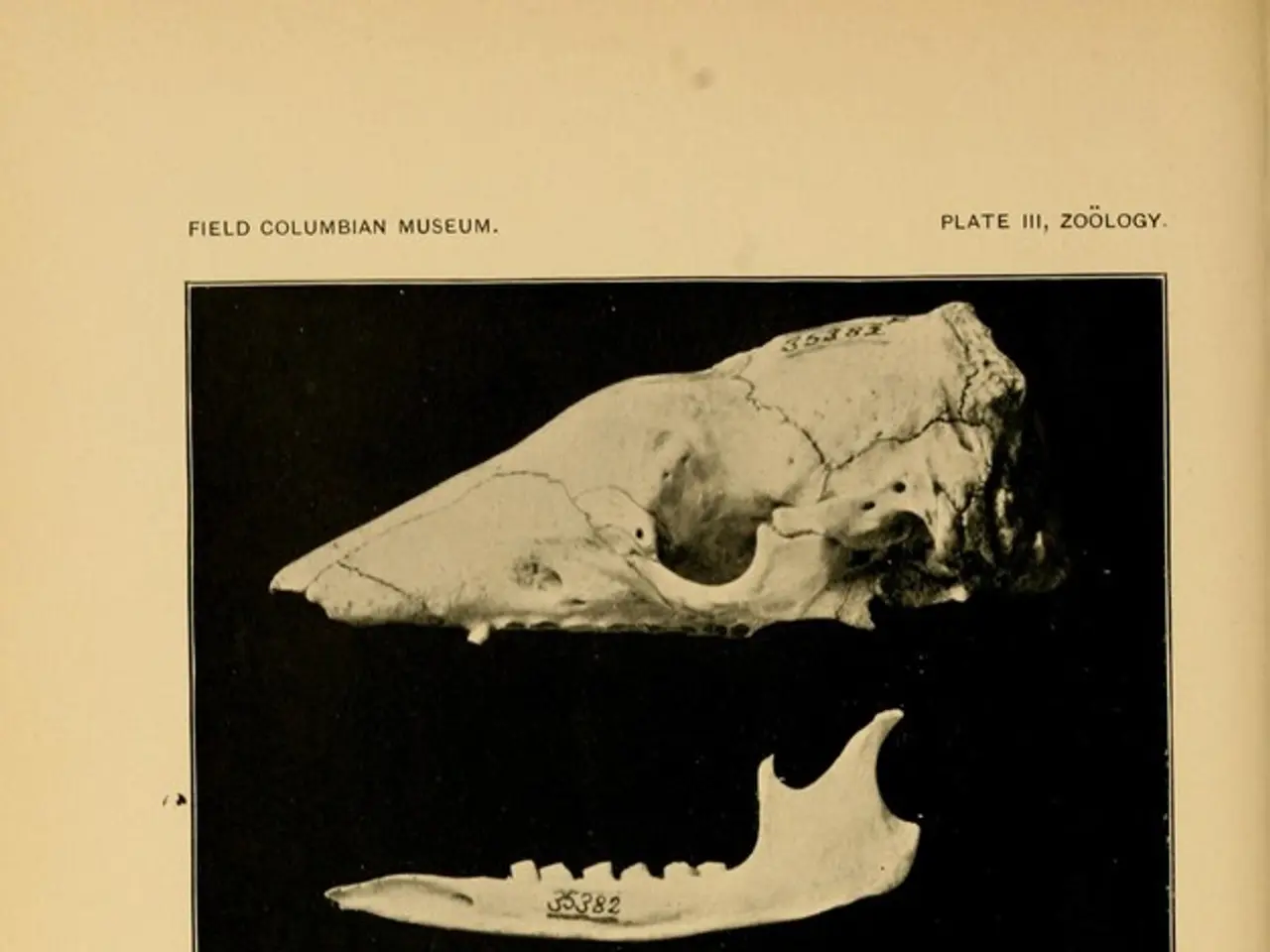Signs and symptoms of coccygeal cancer
News Article: Understanding Tailbone Chordomas: A Rare but Potent Foe
Tailbone chordomas, a rare and often misdiagnosed type of cancer, can cause persistent pain in the coccyx area and potentially lead to nerve-related issues, bowel or bladder dysfunction, and other symptoms [1][2]. These tumors originate from remnants of the notochord, a structure present during fetal development, and typically grow in the spine and the sacrococcygeal area [4].
Despite their slow growth, chordomas can be challenging to treat due to their complex nature. Approximately 70% of cases can have the tumor completely removed without recurrence initially, but the risk of recurrence is around 30% [4]. The best outcome for a patient with a sacral chordoma is the complete removal of the tumor.
Treatment for chordomas usually involves surgical removal, which is the primary treatment option [4]. If complete surgical removal is not feasible, radiation therapy may be used. Additionally, pain management approaches, such as cushioning, oral or topical medications, and targeted injections, are employed to alleviate pain [5]. In severe cases, a coccygectomy (removal of the coccyx) may be necessary.
Research is ongoing, with foundations like the Chordoma Foundation supporting the development of new treatments [4]. However, chemotherapy does not tend to work well in the treatment of sacral chordoma, but it may be used for other cancers if they have spread into the tailbone or sacrum.
The outlook for someone with a sacral chordoma depends on how much of the tumor is surgically removed. Sacral chordomas rarely spread to other areas in the body and often grow back in the same place [4]. The symptoms of tailbone cancer include lower back pain, tenderness, tingling, weakness in the lower back and legs, issues with bladder and bowel function, and a palpable mass in the lower back [1].
It is essential to note that other types of cancer are more likely to spread to the bones, with breast, prostate, lung, thyroid, and kidney cancers accounting for most skeletal metastases [1]. For cancers of the tailbone, treatment may include surgery, radiation therapy, and immunotherapy.
In summary, tailbone chordomas are rare cancers that can cause persistent local pain and nerve symptoms. Treatment mainly involves surgery with possible additional therapies, while survival depends on tumor behavior and completeness of removal. Supportive care for pain and neurological symptoms is essential [1][2][4][5]. Early diagnosis and treatment can improve survival and quality of life for those affected by this rare and challenging cancer.
[1] Mayo Clinic. (2021). Chordoma. https://www.mayoclinic.org/diseases-conditions/chordoma/symptoms-causes/syc-20354834
[2] American Cancer Society. (2021). Chordoma. https://www.cancer.org/cancer/chordoma.html
[3] National Cancer Institute. (2021). Chordoma Treatment (PDQ®)–Patient Version. https://www.cancer.gov/types/bone/hp/chordoma-treatment-pdq
[4] Chordoma Foundation. (2021). What is Chordoma? https://www.chordomafoundation.org/what-is-chordoma/
[5] National Institute of Neurological Disorders and Stroke. (2021). Coccydynia. https://www.ninds.nih.gov/disorders/coccydynia/detail_coccydynia_info.htm
- In addition to tailbone chordomas, chronic diseases such as depression, migraine, brain and central nervous system cancer, obesity, HIV, and various other medical conditions can negatively impact an individual's health and wellness.
- Science has been constantly working to develop predictive models for cancer, as well as therapies and treatments for chronic diseases and mental health conditions.
- The workplace-wellness movement encourages employers to provide resources for fitness and exercise, nutrition counseling, and mental health support to reduce the risk and impact of chronic diseases such as cancer, obesity, and mental health disorders.
- Recently, findings suggest a potential connection between hepatitis and increased risk of various cancers, making it crucial to implement awareness campaigns and implementation of preventive measures in public health.
- Skin care is an important aspect of overall health and wellness, as unprotected exposure to harmful UV rays can lead to skin damage and an increased risk of skin cancer.
- In the study of cancer, researchers often focus on prevention strategies, early detection methods, and innovative treatment options, such as immunotherapy and targeted therapies, to improve patient outcomes.
- Medicare provides coverage for a wide range of medical services and treatments, including those related to cancer, chronic diseases, mental health, and fitness-and-exercise programs, ensuring access to quality care for millions of seniors.
- Despite advancements in cancer treatment, there is a growing concern about the high cost of therapies and treatments, making it difficult for many individuals to afford necessary care for conditions such as cancer, HIV, and depression.
- Research shows that managing chronic medical conditions such as cancer, obesity, and depression requires a multidisciplinary approach that integrates nutrition, exercise, and mental health therapies for optimal outcomes.
- Early detection and effective management of both physical and mental health conditions improves quality of life and overall wellbeing, as demonstrated by studies on depression, obesity, and various types of cancer.
- Although rare, the struggle faced by individuals with sacral chordoma underscores the importance of awareness, research, and support for those battling chronic diseases, as well as the role of science in making strides in understanding and treating these potentially life-changing conditions.




